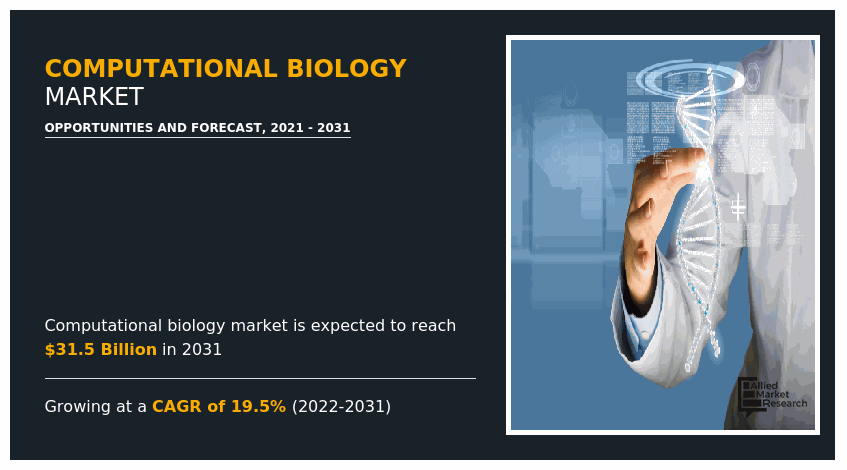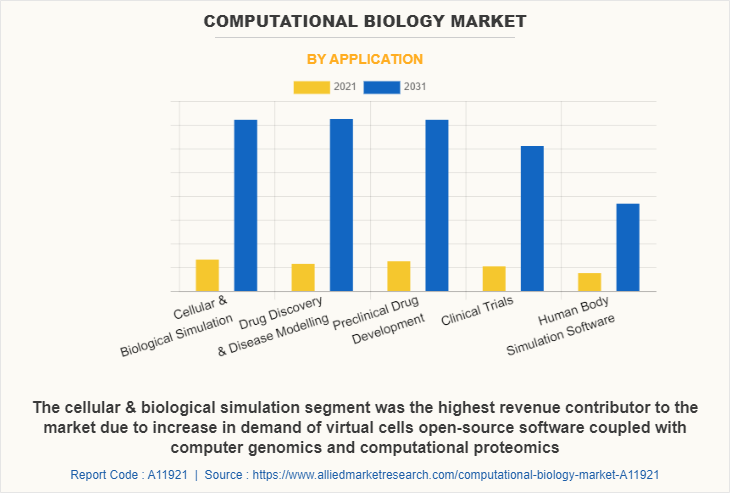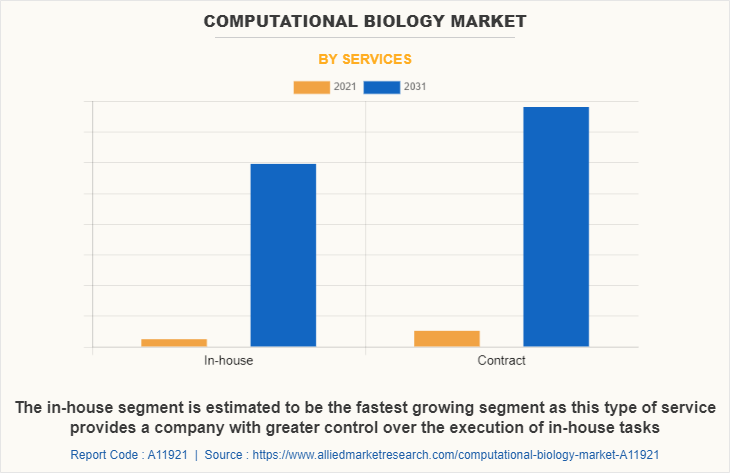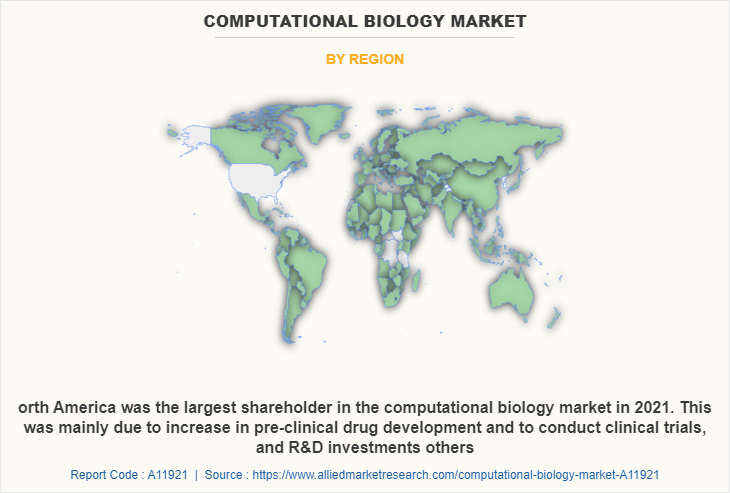
Allied Market Research Forecasts $31.5+ Billion Computational Biology Market with 19.5% CAGR by 2031

In recent analysis by Allied Market Research, it was revealed that the computational biology market experienced remarkable growth, boasting a value of $5.5 billion in 2021. Projections are even more impressive, with expectations set for it to skyrocket to $31.5 billion by 2031. This staggering growth is anticipated to sustain a compound annual growth rate (CAGR) of 19.5% from 2022 through 2031. This trajectory underscores the vital role computational biology plays in various sectors, from pharmaceuticals to biotechnology, promising transformative advancements in research and development.
𝑮𝒆𝒕 𝒂 𝑺𝒂𝒎𝒑𝒍𝒆 𝑪𝒐𝒑𝒚 𝒐𝒇 𝒕𝒉𝒊𝒔 𝑹𝒆𝒑𝒐𝒓𝒕: 𝒉𝒕𝒕𝒑𝒔://𝒘𝒘𝒘.𝒂𝒍𝒍𝒊𝒆𝒅𝒎𝒂𝒓𝒌𝒆𝒕𝒓𝒆𝒔𝒆𝒂𝒓𝒄𝒉.𝒄𝒐𝒎/𝒓𝒆𝒒𝒖𝒆𝒔𝒕-𝒔𝒂𝒎𝒑𝒍𝒆/𝑨11921
Computational biology stands at the intersection of biology and computer science, leveraging the power of computing to delve into the intricate workings of life. At its core, it harnesses computational methods, including sophisticated algorithms, to model biological phenomena and simulate complex biological processes. By employing these computational approaches, researchers can analyze and interpret vast amounts of experimental data, unraveling the mysteries of biological systems on a scale previously unimaginable. This interdisciplinary field holds immense promise, offering insights into everything from genetic interactions to ecological dynamics, ultimately driving forward our understanding of life itself.

Computational biology serves as a bridge between biology and computational science, utilizing a diverse array of computational methods to analyze vast biological datasets, spanning genetic sequences, cell populations, and protein samples. Through analytical techniques, mathematical modeling, and simulation, researchers can unearth new insights and make predictions that drive the discovery of novel biology.
Central to computational biology is the construction of models derived from experimental data, illuminating the functionality of nucleic acids, peptides, and genes. These models elucidate the relationships between genetic expression and phenotypic traits, unveil the molecular underpinnings of diseases, and elucidate the influence of cellular organization on behavior.
The application of computational biology is multifaceted, with bioinformatics technology playing a pivotal role in expediting genomic and proteomic research. In the context of emergent threats like SARS-CoV-2, bioinformatics facilitates rapid characterization of genome structures, variant identification, and elucidation of viral evolution and host interactions. Additionally, molecular dynamics simulations, molecular docking, and AI-driven approaches accelerate drug development by aiding in virtual screening and molecular design.
Looking ahead, the global computational biology market is poised for moderate yet steady growth, fueled by the burgeoning demand for pharmacovigilance solutions, advanced software for drug discovery, and disease modeling across various ailments, including cardiovascular disorders, cancer, and infectious diseases. Moreover, the integration of computational biology tools in diverse fields such as genomics, epigenomics, proteomics, and metagenomics promises enhanced understanding of protein structures and interactions, presenting lucrative opportunities for both established players and new entrants alike.
Key Market Players
𝑪𝒆𝒓𝒕𝒂𝒓𝒂, 𝑬𝒏𝒕𝒆𝒍𝒐𝒔, 𝑪𝒉𝒆𝒎𝒊𝒄𝒂𝒍 𝑪𝒐𝒎𝒑𝒖𝒕𝒊𝒏𝒈 𝑮𝒓𝒐𝒖𝒑 𝑰𝒏𝒄., 𝑪𝒐𝒎𝒑𝒖𝒈𝒆𝒏 𝑳𝒕𝒅., 𝑺𝒊𝒎𝒖𝒍𝒂𝒕𝒊𝒐𝒏 𝑷𝒍𝒖𝒔 𝑰𝒏𝒄., 𝑵𝒊𝒎𝒃𝒖𝒔 𝑫𝒊𝒔𝒄𝒐𝒗𝒆𝒓𝒚 𝑳𝑳𝑪, 𝑹𝒉𝒆𝒏𝒐𝒗𝒊𝒂 𝑷𝒉𝒂𝒓𝒎𝒂 𝑺𝑨𝑺 & 𝑳𝒆𝒂𝒅𝒔𝒄𝒐𝒑𝒆 𝑰𝒏𝒄., 𝑮𝒆𝒏𝒆𝒅𝒂𝒕𝒂 𝑨𝑮, 𝑰𝒏𝒔𝒊𝒍𝒊𝒄𝒐 𝑩𝒊𝒐𝒕𝒆𝒄𝒉𝒏𝒐𝒍𝒐𝒈𝒚 𝑨𝑮, 𝑨𝒄𝒄𝒆𝒍𝒓𝒚𝒔, 𝑹𝒉𝒆𝒏𝒐𝒗𝒊𝒂 𝑷𝒉𝒂𝒓𝒎𝒂 𝑺𝑨𝑺

Complications and Restraints
- Complications such as undetectable allergic reactions and post-surgery complications.
- Unfavorable government scenarios impacting market dynamics.
- High initial and maintenance costs of computational biology instruments.
- Lack of standardization in methodologies.
- Shortage of skilled workforce.
Market Segmentation
By Application:
- Cellular & biological simulation
- Drug discovery & disease modeling
- Pre-clinical drug development
- Clinical trials
- Human body simulation software
- Cellular & biological simulation sub-segments:
- Computer genomics
- Computational proteomics
- Pharmacogenomics
- Others
- Drug discovery & disease modeling sub-segments:
- Target identification
- Target validation
- Lead discovery
- Lead optimization
- Pre-clinical drug development sub-segments:
- Pharmacokinetics
- Pharmacodynamics
- Clinical trials sub-categories:
- Phase I
- Phase II
- Phase III
- Cellular & biological simulation sub-segments:
By Services:
- In-house services
- Contract services
By End Use:
- Academics & research
- Commercial
By Region:
- North America
- Europe
- Asia-Pacific
- LAMEA
Market Dynamics
Application Segment:
- Cellular & biological simulation led the market due to demand for virtual cells open-source software.
- Drug discovery & disease modeling projected as the fastest growing segment owing to increased drug development activities and target selection awareness.
Services Segment:
- Contract services dominated revenue due to cost-effectiveness and customized solutions offered by Contract Research Organizations (CROs).
- In-house services anticipated to grow rapidly due to cost and time-saving advantages.
End Use Segment:
- Commercial sector contributed the highest revenue due to increased R&D investment in genetic engineering and drug discovery.
- Academics & research sector forecasted as the fastest growing segment due to rising demand for disease modeling and population-based sequencing projects.
Regional Analysis
- North America: Largest market share in 2021 due to demand for pharmacovigilance and supportive government initiatives.
- LAMEA: Estimated fastest growth during the forecast period driven by product approvals, increased clinical trial procedures, and demand for advanced computational biology software.

𝑬𝒏𝒒𝒖𝒊𝒓𝒆 𝑩𝒆𝒇𝒐𝒓𝒆 𝑩𝒖𝒚𝒊𝒏𝒈: 𝒉𝒕𝒕𝒑𝒔://𝒘𝒘𝒘.𝒂𝒍𝒍𝒊𝒆𝒅𝒎𝒂𝒓𝒌𝒆𝒕𝒓𝒆𝒔𝒆𝒂𝒓𝒄𝒉.𝒄𝒐𝒎/𝒑𝒖𝒓𝒄𝒉𝒂𝒔𝒆-𝒆𝒏𝒒𝒖𝒊𝒓𝒚/𝑨11921
Editor Details
-
Company:
- The Wire Times
